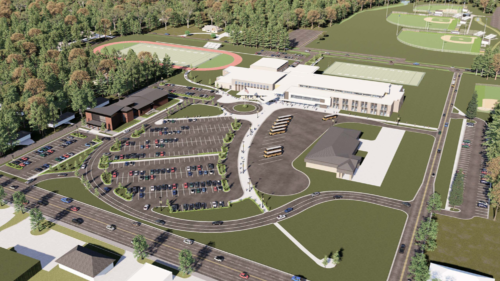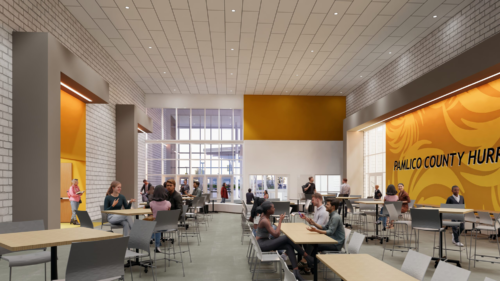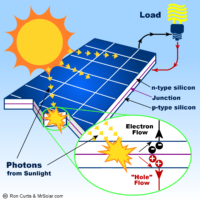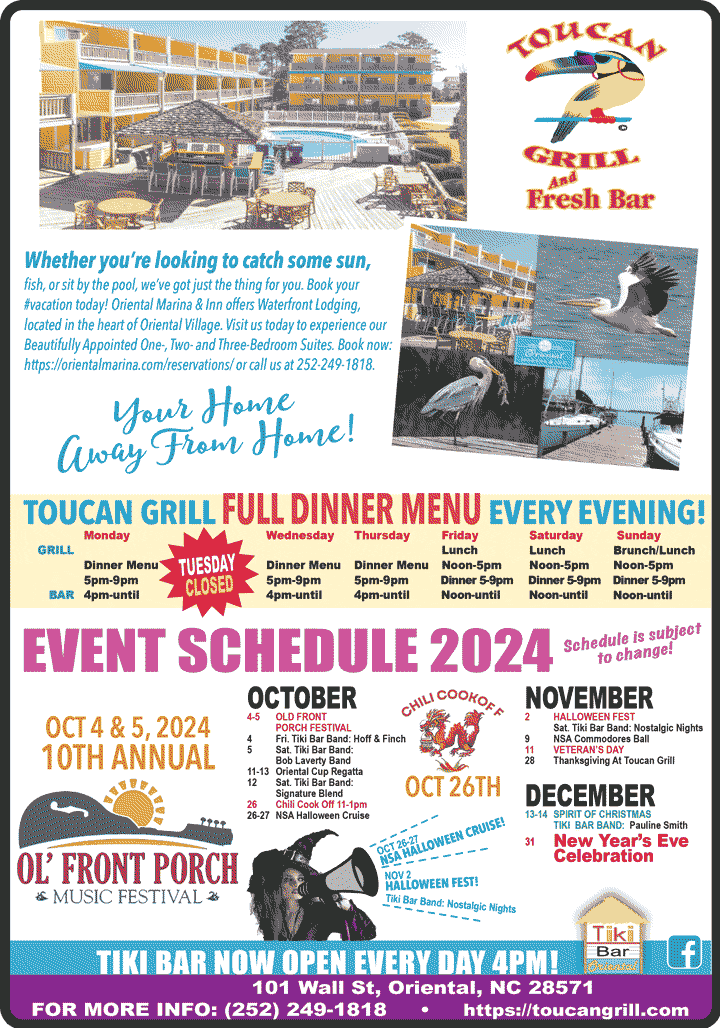
BAYBORO – Pamlico County Schools released a request for bids on June 27, 2024 for construction of a 6th thru 12th grades school. The bids will be opened in public at the current high school auditorium on Thursday, July 27 at 2pm. This article details the quest to get information about this whole process.
Here are some facts to keep in mind. First, USAFacts.Org, publishes these statistics: Data on population changes uses the time frame of 2010 to 2022. Pamlico County – Population change, -5.5%; NC Statewide average, +11.7%, USA Population change, +7.7%. Pamlico County population changes by age group. Largest population loss group ages 5 to 19, – 25.2% . Largest population increase group age 65 and up, +31.6%. This speaks to the increasing numbers of retired people coming to Pamlico for the lifestyle. And they are not people of child-bearing age. What could change this metric to increase the number of students? War could bring more troops to Cherry Point and they might move to Pamlico County instead of Craven or Carteret. Some type of large industry with many employees could bring school children here. However, one must factor in the probability of these two occurrences – at this point, UNLIKELY!!
On its website, Raleigh-based SFL+A Architects estimates total enrollment of 900 students across the seven grades of the middle school / high school combo.
Another issue to consider is the availability of state/federal education monies to be used in teaching our children. School systems are funded based on the number of students and what tier the county school system is in. The tier arrangement is: 40 counties are very poor and are rated Tier 1. Another 40 counties are rated somewhat poor and get the 2 rating. The richest 20 counties make up Tier 3. Four factors are used to generate the tier ratings, but that will not be covered here. Pamlico and Craven are both Tier 2, Carteret is Tier 3, Beaufort and Onslow are Tier 1 counties. Government funding for schools provide the least amount per student for Tier 3 counties, medium amounts for Tier 2, and the highest amount for Tier 1 counties. Changes in Pamlico County factors or changes in factors in the other 99 counties could move Pamlico to a different tier.
Government funding is allocated per student, and is paid to the school where the student is enrolled. This allows parents to choose the school that best fits their view of life, liberty and the pursuit of happiness. Pamlico County Schools enroll about 1,200 to 1,240 children. According to a school official, about 80 students are from out-of-county.
Arapahoe Charter School (ACS) has about 475 total students with 190 domiciled in Pamlico. A larger number of students come from Craven County, and ACS supplies some bus transportation to Craven including two bus stops on Marine Corp Base Cherry Point. Other students come from Beaufort, Carteret, and even one from Onslow County.
Pamlico Christian Academy has about 270 students. They are raising money to build a new school on Hwy 55 west of Hwy 306. About 60 percent of their students come from Pamlico County. Like all schools, their NC students bring their funding from the state/federal government with them.
Another factor is the number of home-schooled students in North Carolina. These students’ families receive no state or federal monies at all! They are adamant about NOT receiving any money as it could force teachings that are contrary to their family beliefs. North Carolina leads the nation in percentage of students being home-schooled at 10.6% for a total number of 179,900 students. Florida is second with 4.6% and 143,800 students. Wokeism and revisionist history seem to be the driver of this metric.
More Photos:
(Click on photo to enlarge)
Important Topics To Consider:
The bid notice listed 42 items, but there is not an item for the demolition of the Middle School, which seems to be the cause for replacing the high school and track/football field. It can’t be left in place as the next major hurricane may flood it and will have a mess of mold as well as leaving an eyesore.
Item 10 – EFIS. This is probably a typographical error as it stands for Electronic Flight Instrument System, commonly know as a “Glass Cockpit” for commercial and private aircraft. It should probably
be EIFS, Exterior Insulation Finishing System, which is a high tech covering for the outside of the building. Researching the types of EIFS systems, I learned there are five major manufacturers of this type of product. Unfortunately, there are some 15-plus more that are not well known. DryVit is one of the five EIFS companies. I asked an architect friend for his opinion on EIFS products, and his response was less than enthusiastic. This matched my experience back in Colorado some 20 years ago.
We lived in a small community in Colorado that was architecturally designed similar to homes in San Marino, Italy. Our home was built with “real” stucco. That is, the house was wrapped in 3/4″ plywood, that was covered with tar paper, then chicken wire was nailed on. Then concrete was troweled on and given a bumpy finish as you would expect of stucco. The key thing with our house was that “fabric” was added to the concrete to resist cracking. The “fabric” was millions of one inch pieces of fibreglas. We developed a place on the back patio that required repair, and I was able to do it myself without any training or expensive equipment.
The original developer went under and the community found a custom home builder to come in and finish off the community in the same San Marino style. Unfortunately, the new builder used DryVit, an EIFS system, which exterior uses thick blocks of plastic foam insulation attached to a plywood exterior of the home. Then an open-weave fibreglas fabric is laid over the plastic blocks for the exterior finish product to be troweled on. Within 10 years, those homes had black mold attacking the wood exterior behind the plastic foam blocks. The damaged areas required the exterior to be removed, the mold treated, the wood replaced, and the exterior fibreglas fabric and plasticized cement top coat to be replaced. Some windows also had to be replaced. AN EXPENSIVE REPAIR! This occurred in Colorado where humidity was relatively low. My concern is that in North Carolina humidity is high more than half the year, resulting in air conditioning blowing cold air on the back side of the foam insulation where condensation could collect and cause mold to develop.
Once I find out who the preferred vendor for the EIFS is, I have a bunch of questions, including: Are they using a rain drain system? What is the process for repairing the EIFS when a tornado or hurricane hurls a tree limb at it? Does it require specialty workmen to repair the under-layment to protect against mold? Will the exterior use the ‘double product’ system for extra strength?
I looked up DryVit. The warranty appears to be limited to two years, but an optional extension may be available with DryVit pre-approval and an additional premium prepaid.
My personal opinion is that the two year warranty is a joke. For state-of-the-art, two years is totally unacceptable. I think for a building that is to last 40-plus years, a warranty should be at least 20 years and the school system should be ready to pony up the millions of dollars it will cost in 2046 for the repair.
Repairs must be made by a certified repairman. The application range of temperature is tight as higher temps limit the work life of the product and minimum temps above 40 degrees F for 24 hours after application. The coatings reach maximum strength in 24 hours. There is no warranty if the outer coating is punctured. The color is warrantied for 10 years if standard color and 5 years for non-standard color. Woodpeckers can be a problem unless the extra strength second coating is added. We don’t know if or what the fire rating is. Should the exterior coating or plastic foam burn, we don’t know if the smoke is poisonous.
This newspaper has attempted to review a set of floor plans and specifications to no avail. We would like to know what the floor plan is for this school. Since the preamble states, “This project will include a new state-of-the-art high school….” When we lived in Arizona, “state-of-the-art” was code for no interior walls between all the classes. We don’t know if that is what is proposed here or not.
Our new neighborhood school in Tempe, AZ was proposed to be a very open plan. Our next door neighbor was getting info from an insider on the school board. She wanted help to change things. The school board wanted visitors to come during quiet hours. We intentionally visited during ‘off quiet hours.’ The noise was DEAFENING. We went into a little alcove with a door separating it from the main room. There we found a student resting on some rolled up carpet reading his text book. We asked why he was there? He replied: “It is the only quiet place in the school.” We worked together with the neighbor and school board member to get the plans changed to having only two classes in each walled space. We considered that a victory for the kids.
In the request for bids (as mentioned earlier) there was no call for demolition of the Middle School. Why? This is the original problem since it was flooded by Hurricane Irene in 2011 and Hurricane Florence in 2018. The Middle School took steps to cut losses for future flooding when damage from Irene was repaired.
Item 35 – HVAC. Here in eastern NC there is airborne salt, which condenses on the indoor coil where the salt solution attacks the coil and causes refrigerant to leak over time. That time can vary from 8-10 years, or in some cases around 18-20 years. Are the indoor coils covered by a substance to keep the salt air off the coil? These are a large expense that will only increase with time as materials and refrigerant costs continue to escalate.
Item 36 – Geothermal. I assume this is a ground water heat pump system. What type is it and what engineering firm provided the specifications for that portion of the project? Can one assume the engineering firm will be held liable if the performance is less than specified? If a competent professional engineer designed the system and antifreeze is the medium to circulate in the ground portion of the system, then this could be a good idea. May one assume the system will consist of buried water pipe to avoid mineral buildup and wasting water that a pump and dump systems would have? I would hope the specs call for a delay in the compressor restart after AC power is lost and until the AC power is steady (clean power) for five minutes so the compressor and heat exchanger don’t overheat.
Item 37- Electrical including Communications and Fire Alarm. Can one assume there will be a 5G WiFi system? If so, will the 6th thru 8th grades be shielded from the RF energy that the system will radiate into the classrooms, halls, gyms, cafeteria, labs and so on? US standards for radio frequency are based only on heating effect on human bodies, a practical measurement system as it is relatively easy to measure, but totally ignores cancer and mental health risks. Unfortunately, damage to the human body occurs at much lower levels than where the heating effect becomes a factor. Damage is defined as cancer causing, poor sleep performance, or brain effects. Europe allows much less RF radiation than the US does. This is why the European community takes US style measurements and divides them by 10 or 100 to derive safer standards. In fact, European schools up through our middle school age equivalent allow NO WiFi in those schools. In European schools up to 8th grade, students and faculty use Ethernet cables for internet connections. For high school aged students, they begin using WiFi, but not 5G as those routers have two transmitters which about doubles the RF energy levels.
Item 42 – Photovoltaic Panels. If the purpose is to have a demonstration system to teach the students how photovoltaic solar panels that generate DC voltage work and what kind of energy they produce, then this is a good idea. If the plan is to run the school off of the system, in whole or significant part, then that is a bad idea. Does the spec call for insurance for the panels against ElectroMagnetic Pulse, also known as EMP? I tried to get that insurance coverage on a proposed system – panels, inverters, and batteries – for my home, but both the seller and I failed to find a company that would cover EMP. Neither Chubb and Lloyds of London would touch solar. Even if no EMP happens, solar panels will lose output power to a point where the output will be 20 percent less in 20 to 22 years, which is considered the point of having to replace the panels. They cannot be recycled since the Cadmium in the panels is considered a toxic waste, which keeps them from being disposed of in a landfill. It will be expensive to dispose of them. Where will the money come from to replace and dispose of the panels?
Are the exterior window glass and doors bullet-resistant? Classroom doors? Is there a force majeure clause in the contract?
How does construction insurance work on this project? Homes under construction can only be insured for one year. Do commercial construction projects have a possibility of two or three year coverage?
Is there insurance on the new school to cover replacement if there are problems during and after construction? Does the School Board know the price of insurance on a $70 million structure?
What is the plan for building the new $22 million stadium after the current stadium is demolished for the new school? Questions, questions? A big question is what happens if the project runs over-budget due to weather, project change notices, materials cost or labor? One would hope all of these will be answered satisfactorily.
Editor’s note: Have a question for Mr. Allison. Send an email to jeff@compassnews360.com and we will pass along your inquiry.
Related posts:

Gordon is a frequent contributor to The County Compass

















































